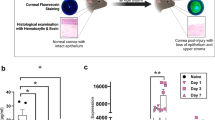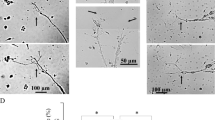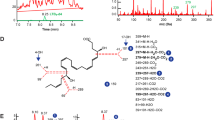Abstract
During development, semaphorins (collapsin, fasciclin) mediate repulsive and inhibitory guidance of neurons1–4. Semaphorin III, a secretable member of this family, is expressed by the ventral spinal cord at the time corresponding to projection of sensory afferents from the dorsal root ganglion (DRG) into the spinal cord6. The inhibitory effect of E14 ventral cord is active only on nerve growth factor (NGF)-responsive sensory afferents (smalldiameter A-delta and C fibers subserving sensations of temperature and pain)5. Similarly, COS cells secreting recombinant semaphorin III are able to selectively repel DRG afferents whose growth is stimulated by NGF and not NT-3 (ref. 7). However, it is not known whether these molecules can exert a functional role in the fully developed adult peripheral nervous system. In this study, we demonstrated that gene gun transfection and production of semaphorin III in corneal epithelial cells in adult rabbits in vivo can cause repulsion of established A-delta and C fiber trigeminal sensory afferents. In addition, it is shown that, following epithelial wounding and denervation, semaphorin III is able to inhibit collateral nerve sprouts from innervating the reepithelialized tissue. These findings are significant in that they provide direct evidence that small-diameter adult sensory neurons retain the ability to respond to semaphorin III. In addition, the corneal gene gun technique may be generally used to study the in vivo effects of neural growth modulators by quantifying the amount of sensory nerve growth.
This is a preview of subscription content, access via your institution
Access options
Subscribe to this journal
Receive 12 print issues and online access
$209.00 per year
only $17.42 per issue
Buy this article
- Purchase on Springer Link
- Instant access to full article PDF
Prices may be subject to local taxes which are calculated during checkout
Similar content being viewed by others
References
Kolodin, A.L. et al. FasciclinIV: Sequence, expression, and function during growth cone guidance in the grasshopper embryo. Neuron 9, 831–845 (1992).
Kolodin, A.L., Matthes, D.J. & Goodman, C.S. The semaphorin genes encode a family of transmembrane and secreted growth cone guidance molecules. Cell 75, 1389–1399 (1993).
Luo, Y., Raible, D. & Raper, J.A. Collapsin: A protein in brain that induces the collapse and paralysis of neuronal growth cones. Cell 75, 217–227 (1993).
Wright, D.E., White, F.A., Gerfen, R.W., Silos-Santiago, I. & Snider, W. D. The guidance molecule semaphorin III is expressed in regions of spinal cord an periphery avoided by growing sensory axons. J. Comp. Neurol. 361, 321–333 (1995).
Tanelian, D.L. & Beuerman, R.W. Responses of rabbit corneal nociceptors to mechanical and thermal stimulation. Exp. Neurol. 84, 165–178 (1984).
Fitzgerald, M., Kwiat, G.C., Middleton, J. & Pini, A. Ventral spinal cord inhibition of neurite outgrowth from embryonic rat dorsal root ganglia. Development 117, 1377–1384 (1993).
Messersmith, E.K. et al. Semaphorin III can function as a selective chemorepellent to pattern sensory projections in the spinal cord. Neuron 14, 949–959 (1995).
Maclver, M.B. & Tanelian, D.L. Structural and functional specialization of A-delta and C fiber free nerve endings innervating rabbit corneal epithelium. J. Neurosci. 13, 4511–4524 (1993).
Beuerman, R.W. & Rozsa, A.J. Collateral sprouts are replaced by regenerating neurites in the wounded corneal epithelium. Neurosci. Lett. 44, 99–104 (1984).
Tanelian, D.L. & Monroe, S. Altered thermal responsiveness during regeneration of corneal cold fibers. J. Neurophysiol. 73, 1568–01573 (1995).
Rozsa, A.J. & Beuerman, R.W. Density and organization of free nerve endings in the corneal epithelium of the rabbit. Pain 14, 105–120 (1982).
Tanelian, D.L., Barry, M.A., Johnston, S.A., Le, T. & Smith, G.M. Controlled gene gun delivery and expression of DNA within the cornea. BioTechniques 23, 484–488 (1997).
Williams, R.S. et al Introduction of foreign genes into issues of living mice by DNA-coated microprojectiles. Proc. Natl. Acad. Sci. USA 88, 361–333 (1995).
Ebendal, T., Olson, L. & Seiger, A. The level of nerve growth factor (NGF) as a function of innervation. Exp. Cell Res. 148, 311–317 (1983).
Nguyen, D.H. et al. Growth factor and neurotrophic factor mRNA in human lacrimal gland. Cornea 16, 192–199 (1997).
Helm, R.S., Cubitt, A.B. & Tsien, R.Y. Improved green fluorescence. Nature 373, 663–664 (1995).
Smith, G.M. et al Astrocytes infected with replication-defective adenovirus containing a secreted form of CNTF or NT3 show enhanced support of neuronal populations in vitro. Exp. Neurol. 139, 156–166 (1996).
Hopp, T.P. et al A short polypeptide marker sequence useful for recombinant protein identification and purification. Biotechnology 6, 1205–1210 (1988).
Evan, G.I., Lewis, G.K., Ramsay, G. & Bishop, J.M. Isolation of monoclonal antibodies specific for human c-myc proto-oncogene product. Mol. Cell Biol. 5, 3610–3616 (1985).
Tanelian, D.L. & Maclver, M.B. Simultaneous visualization and electrophysiology of corneal A-delta and C fiber afferents. J. Neurosci. Meth. 32, 213–222 (1990).
Author information
Authors and Affiliations
Rights and permissions
About this article
Cite this article
Tanelian, D., Barry, M., Johnston, S. et al. Semaphorin III can repulse and inhibit adult sensory afferents in vivo. Nat Med 3, 1398–1401 (1997). https://doi.org/10.1038/nm1297-1398
Received:
Accepted:
Issue Date:
DOI: https://doi.org/10.1038/nm1297-1398
This article is cited by
-
Adult expression of Semaphorins and Plexins is essential for motor neuron survival
Scientific Reports (2023)
-
Vinaxanthone inhibits Semaphorin3A induced axonal growth cone collapse in embryonic neurons but fails to block its growth promoting effects on adult neurons
Scientific Reports (2021)
-
The Semaphorin 3A inhibitor SM-345431 preserves corneal nerve and epithelial integrity in a murine dry eye model
Scientific Reports (2017)
-
CRMP1 Interacted with Spy1 During the Collapse of Growth Cones Induced by Sema3A and Acted on Regeneration After Sciatic Nerve Crush
Molecular Neurobiology (2016)



